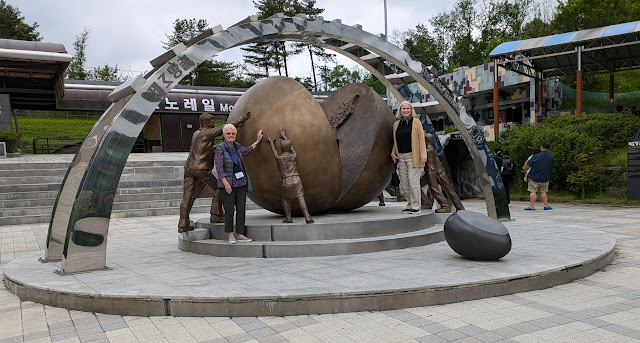Road Scholar Trip to South Korea, May 13-27, 2025
Part I: Seoul to Gyeongju
Korea is 1/100 the size of the U.S. with 1/7 the population (51.71 million), squeezed between Japan and China. Korean, a very logical, scientific language created in 15th century and brought back after 400 years, is called Hangeul with 24 letters. It is the 12th language in the world, and thus perhaps Koreans are the most literate people in the world. It is a mountainous country: only 30% is flat. We had an excellent lecture on Culture (symbols, language, beliefs, norm's and values) by Andrew Eungi Kim and Modern History of the 2 Koreas by Daehoon Lee, Peace researcher and consultant.Korea's history is complex. Here's a very simplified and brief summary. From 57 BC-668 AD there were 3 kingdoms: Goguryeo (north, now centered around Pyongyang) Silla (east) and Baekje (central). and stretched into Manchuria. By 918, the Goryeo dynasty was established,and expanded and ruled the whole Korean peninsula until 1392, when the Joseon/Chosen, longest and last dynasty (King Taejo) which ruled for 500 years, replacing Chinese Buddhism with Neo-Confucianism. Buddhist monks and temples were mostly exiled to the mountains.
In 1897 the king declares the Korean Empire, and ends ties to China (which had greatly influenced culture, language and statecraft). In 1900, modernization continues with the opening of a railroad, public lighting, a streetcar system in Seoul. As Japan smashed Russia, defeated China in 1895, took Korea as a protectorate in 1905, and in 1910, effectively annexed Korea. There were protests and a big student uprising in 1929, which led to the strengthening of the Japanese military and curbed freedom of the press. With Allied victory over Japan in 1945, Korea was liberated from Japan, but divided into 2 protectorates, the Soviets in the North, US in the South.
Between 1947 and 1953, as many as 30,000 Jeju Islanders are massacred by right wing government forces. The Korean War, triggered by a north Korean invasion over the 38th parallel, occupying Seoul. 10 countries, with 30,000,000 killed, 4 million (10% of the population) Koreans, the country mostly destroyed. The end of the war in 1953 is followed by dictatorships, corruption, coups, but rapid economic growth, urbanization. In 1998 the first fully civilian, democracy is formed. But as we see, the last president Yoon Suk-yeal was removed in December 2024, after he declared martial law. June 3,2025, Lee Jae-myung , a former human rights lawyer who led the impeachment, is the elected new President, hoping for improved relations with North Korea. His top opponent was from Yoon's government.
Lots of murals, digital projections on buildings on the very clean, safe streets, gracious, well-groomed, fit-looking people,with beautiful skin!
The rain doesn't stop them from crowding the streets of Seoul, with 9.6 million and more tall buildings than I have ever seen.
And I have never seen so many small dishes of mostly plant or sea-based dishes. Some spicy, like kimchi. No knives, just forks, spoons and chopsticks! Elaine Klemm was a fun travel companion. We were a group of 13 with a very enthusiastic and knowledgeable tour leader, Jennifer, of Jeju Island, Korea. We traveled by train, bus, and flew to the island and back to Seoul.
Changdeokgung Palace (built 15th century as a secondary Joseon palace) destroyed by the Japanese invasion in 1590's, and rebuilt as primary royal residence in 1872. King and queen had separate houses.
In the palace's dense woodland is the Secret Garden, Huwon.
At the Demilitarized Zone, 38th parallel, we saw the tracks, bridge and train that connected South and North---no longer, and a car shot with bullet holes.
Between 1931-1945 and beyond, Japanese military took young Korean women as sex slaves or comfort women. Japan refused reparations.
From the Observatory we could look into North Korea, connected by Freedom Bridge. There is one S. Korean village left and a N. Korean industrial complex, flags of each in the distance.
We walked into the tunnels through which N. Korean soldiers came to attack Seoul.
Celadon reached a peak in Korea.It's made in clay kilns which allows no oxygen inside. We saw beautiful pieces, along with Buddhas and gold jewelry, etc. in the National Museum
Sunday Protestant worship service with block-long participation
Lunch at Maji Vegan restaurant: Olivia, Elaine, Miriam, Angie, Lisa, Kun, Betsy, Mary
Changing of the Guard at Deuksugong Palace, one of 5 built during the Joseon dynasty. Below, City Hall, beautiful inside with hanging plants.
Gwangjang Market is lively and crowded on Sunday afternoon.
These waffle-like pastries, taiyaki filled with sweet bean, Nutella, custard, etc. were so delicious! Taiyaki (seabass) originated in Japan and are in the shape of a fish.
Seoul Cathedral. Catholicism was brought by the French about 1775, and about 11,000 were martyred at some point. Today Korea is #2 after the Philippines in the number of Christians (30%). 20% of S Koreans practice Buddhism (legalized in 1910), 50% have no specific beliefs.
Dinner at old temple garden restaurant, former home of the father of last king.
Gwanghwamun -Gu, with mythical creature, gate to Gyeongbokgung Palace (1395) of King Taejo, founder of Joseon dynasty.
One of 6/8 remaining gates to the city (whose walls are mostly gone). Sukjeongmin or north gate.
We took the bullet train to Gyeongju, known as the "museum without walls" which has more tombs, temples, pagodas, rock formations, Buddhist statuary and palace ruins than any other place in South Korea. Beautiful place and coastal city in far southeast.
Our bus with beautiful curtains, fringe and handy toilet paper as tissue!
Cheomseongdae observatory. This city attracts so many young visitors
23 round grassy tombs called Tumuli contain Silla monarchs and family members. This Heavenly Horse Tomb was built around the 5th century, and contained fabulous treasures (gold crowns, bracelets, jade, weapons), many in the museum nearby
We enjoyed a cooking class to make bulogi
Cooking with Kun, Olivia, Bik and Kat, then eating our results!


































































No comments:
Post a Comment